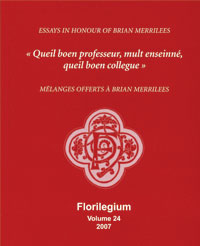The French Presence in Medieval Scotland: Le roi René and King Hart
Résumé
Most authorities agree that King Hart diverges so much from René d'Anjou's Le Livre du Cuer d'amours espris that the French text ought not to be considered a source for, or analogue to, the one in Scots. It is true, Cuer presents itself as an allegorical quest romance of love in the tradition of the Roman de la Rose, and King Hart as a religious allegory of the life of man wherein carnal love proves wanting. However, King René's pseudo-autobiographical Livre du Cuer was so well known in the fifteenth century that a cultured audience listening to the tale whose hero is King Hart would have made the connection. King Hart spends his misspent erotic life in the castle of Plesance, his mistress, who leaves when he grows old. René's Cuer arrives at the castle of Plaisance where Amour dwells. Another of René's books, Le Mortifiement de Vaine Plaisance, is a moral allegory, similar to King Hart, in which Vaine Plaisance is purged from the protagonists — she leaves. This article argues that the author of King Hart knew both of René's texts, and that he took from them what he needed to compose his own intertextual book of the heart, which is both an anti-René and a super-René.Téléchargements
Publié-e
2007-01-01
Comment citer
Calin, W. (2007). The French Presence in Medieval Scotland: Le roi René and King Hart. Florilegium, 24, 11–20. Consulté à l’adresse https://journals.lib.unb.ca/index.php/flor/article/view/12561
Numéro
Rubrique
Medieval French Literature Across Borders / A travers les frontières



